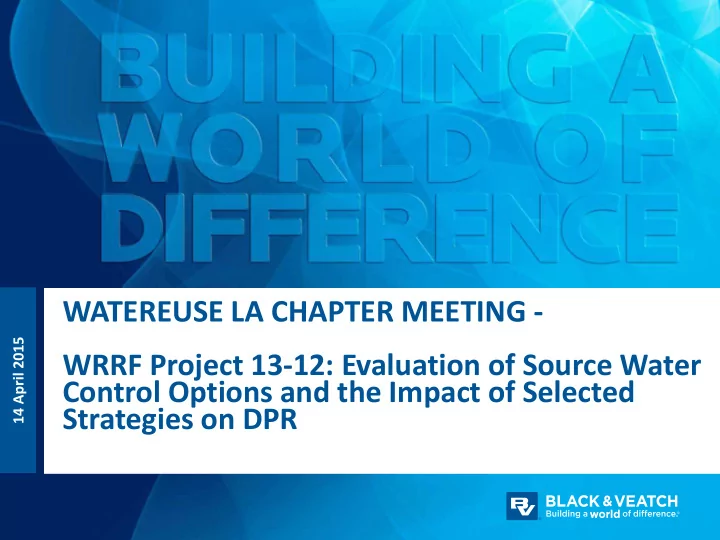

WATEREUSE LA CHAPTER MEETING - 14 April 2015 WRRF Project 13-12: Evaluation of Source Water Control Options and the Impact of Selected Strategies on DPR
WATEREUSE RESEARCH FOUNDATION (WRRF) PROJECT 13-12 • Funded by CA Direct Potable Reuse (DPR) Initiative • WRRF Project 13-12 Project Objectives: • Evaluate upstream wastewater treatment impacts on DPR source water and downstream advanced treatment processes • Assess the impact of hydraulic control mechanisms on influent water quality and flow variations that may stress advanced treatment process for DPR applications 2
CASE STUDIES FOR WRRF PROJECT 13-12 • Case Study 1 = Orange County Sanitation District (OCSD) and Orange County Water District (OCWD) • Case Study 2 = City of Los Angeles Bureau of Sanitation and West Basin Municipal Water District • Case Study 3 = City of San Diego • Case Study 4 = Singapore Public Utilities Board 3
CASE STUDY 1: ORANGE COUNTY SANITATION DISTRICT (OCSD) AND ORANGE COUNTY WATER DISTRICT (OCWD) • Source water for OCWD’s AWPF = 75:25 of activated sludge to trickling filter effluent • No flow equalization currently available, thus treatment performance impacted by diurnal flow variations • Minimal contribution from plant return streams in AWPF source water 4
CASE STUDY 2: CITY OF LOS ANGELES BUREAU OF SANITATION AND WEST BASIN MUNICIPAL WATER DISTRICT • Source water for West Basin’s AWPF = secondary effluent from high purity activated Hyperion Treatment Plant sludge process • Secondary effluent quality impacted by plant return streams • Constant secondary effluent flow to West West Basin ECLWRF Basin’s AWPF 5
CASE STUDY 3: CITY OF SAN DIEGO • Source water for AWPF = tertiary effluent • Fully nitrified/ denitrified secondary effluent • Primary flow equalization provided at WWTP • No plant return flows within WWTP (scalping plant) 6
CASE STUDY 4: SINGAPORE PUBLIC UTILITIES BOARD • Source water for AWPF = secondary effluent from MBR • Fully nitrified/ denitrified secondary effluent • Secondary effluent flow equalization provided at WWTP 7
Aerial view of OCSD Plant 1 and OCWD GWRS Facility
OCSD Plant 1 Secondary Treatment Facilities Trickling Filter Facility (P1-76) = 30 MGD Secondary Activated Sludge Facility 1 (P1-82) 75 MGD Secondary Activated Sludge Facility 2 (P1-102) 60 MGD N 9
SOURCE WATER FOR OCWD’S AWPF • Quality: 5 NTU Monthly / 10 NTU Instantaneous • Diurnal Flow Variations • Blend of 25% Trickling Filter (TF) Effluent to 75% Nitrified Activated Sludge Effluent (P1-102) • TF Effluent = non-nitrified, ammonia used for chloramine formation • Lower cost treatment with TF than Activated Sludge 10
IMPACT OF SECONDARY EFFLUENT QUALITY ON MF PRETREATMENT AT AWPF 14 TF Effluent + CBOD NdN Mode 12 Removal Only P1-102 NdN MF Daily Average TMP (Psi) 10 Online 8 6 4 2 0 Date 11 MF Train B05
SIMILAR TREND AMONGST ALL MF TRAINS 14 12 10 MF Daily Average TMP (Psi) 8 6 4 2 0 -2 Date MF Train B05 MF Train A01 MF Train D08 12
IMPACT OF TF CONTRIBUTION ON “SOURCE” WATER QUALITY FOR AWPF 60 30 % of Trickling Effluent in OCWD FeeD Flow P1-102 NdN TF Effluent + CBOD NdN Mode 50 25 Removal Only Online 40 20 Turbidity (NTU) 30 15 20 10 10 5 0 0 Date TF % MF Feed Turbidity 13
IMPACT OF TF CONTRIBUTION ON RO SYSTEM 60 40 %TF Contribudtion to Total Feed Flow to OCWD GWRS 35 50 30 Daily Average RO ∆ P (Psi) 40 25 30 20 15 20 10 10 5 0 0 Date TF% RO C01 Stage 1 DP RO E03 1st Stage DP 14
ON-GOING RESEARCH WORK FOR WRRF 13-12 • Quantify performance of other AWPFs with different “source” water qualities (e.g. tertiary effluent, high-purity oxygen AS secondary effluent, and MBR effluent) • Review source control/industrial pretreatment programs of each utility partner • Compare primary vs secondary effluent flow EQ and its impact on AWPF treatment performance • Site visit to complete case studies 15
www.bv.com
Recommend
More recommend